
This month’s community support selection is PotterDraw, a software project to very easily generate vases and other cylindrical shapes.
Each month Fabbaloo selects a worthy non-profit project or activity contributing to 3D printing and provides not only a published story on the project, but also free advertising on our well-read pages. If your project would like to take part in the program, please fill out our application form here.
PotterDraw is an open source software project aimed at helping designers easily produce 3D models of cylindrical shapes typically used in pottery. PotterDraw’s Chris Korda explains:
PotterDraw is a free app that lets you easily design pottery for 3D printing in full color. It’s useful for creating cylindrical shapes such as pots, flasks, vases, bowls, plates, cups, glasses, goblets, or anything similar. You draw the pot’s outer wall using a spline, which consists of curved or linear segments. The inner wall is generated automatically. You can also apply effects to the pot’s 3D mesh and texture. The effects can be modulated with oscillators, and the modulations can be animated to create shape-morphing videos.
The texture can be a user-specified image file, or it can be synthesized from a color palette. In either case the texture can be customized with various effects that alter the texture mapping via periodic functions. For example you can map the texture in stripes, rings, kaleidoscope-like petals, or in polar coordinates so that a circular image is neatly centered on the bottom of the pot.
Your pot can be exported as a 3D model in various common 3D file formats, including STL, PLY, and Wavefront OBJ. The PLY and OBJ exports both support full color 3D printing, and the PLY export supports both texture mapping and vertex color. You can also export high-resolution 2D images as BMP or PNG files. There’s a built-in palette editor, and the spline editor has sophisticated editing features such as grid and snap to grid, rulers, cut and paste, translation, scaling, and rotation.
The app has a modern user interface that includes 2D printing with print preview, full screen mode, a tabbed MDI interface with dockable bars, unlimited undo and redo, and context-sensitive help. A library of basic shapes to use as starting points for your own creations is included.
This sounds pretty good, but surely one can use any number of 3D CAD systems, including free web-based services, to do the same thing? Korda explains the difference:
PotterDraw is much easier to use than general-purpose CAD programs which often have steep learning curves. CAD programs typically require you to construct objects in 3D space, which is very challenging for novices, but PotterDraw totally bypasses this, by automatically turning your 2D spline into a valid 3D shape so that you don’t have to deal with construction at all. If you’ve ever drawn a curve in a 2D vector drawing program such as Illustrator, CorelDraw, or InkScape, PotterDraw’s spline editor will feel familiar. You drag the Bezier curve points around and the 3D pot immediately changes shape to match your spline. It really is that easy and intuitive.
In addition to simply drawing the outline of your pot, PotterDraw also lets you modify the resulting shape using a variety of mesh effects. These mesh effects have simple parameters that can be learned quickly by playing with them, unlike analogous features in other CAD programs that often require considerable training and specialized knowledge. You can use PotterDraw’s effects without even considering how to construct the resulting 3D surfaces. This is yet another way in which PotterDraw facilitates immediate expression of aesthetic impulses without demanding up-front investment in complex skills.
PotterDraw is also free and open-source, unlike most CAD programs which are typically prohibitively expensive. But where PotterDraw really shines in its support for full color. Color models are already useful in 3D animation, and objects created in PotterDraw can be readily imported into animation software. Full color 3D printing is still an emerging field, but it’s the future and PotterDraw is ready for it.
And that’s something that perhaps puts PotterDraw ahead of its time. While today we typically see monochrome 3D printers in the field, there will come a day when full color 3D printers are far more common and much more accessible. When that day comes, you might want to have PotterDraw handy.
I must say this program is quite complete; it includes easy methods of generating cylindrical shapes with flutes, scallops, ripples, bends, bumps, pits, helix, and can vary them in frequency, size and several other factors. Here’s a selection of some variants that can be generated:

There is an equally impressive set of color surface application techniques.
The best part is that this system is available for free: it’s an open source product. If there were one aspect to detract from this concept, it’s that it is available only for Windows platforms.
If you’re interested in generating some very unique and highly 3D printable shapes of this type, you really should check out PotterDraw.
And if you know of another nonprofit / open source project that should can take advantage of our community support program, please fill out our form.
Via PotterDraw

